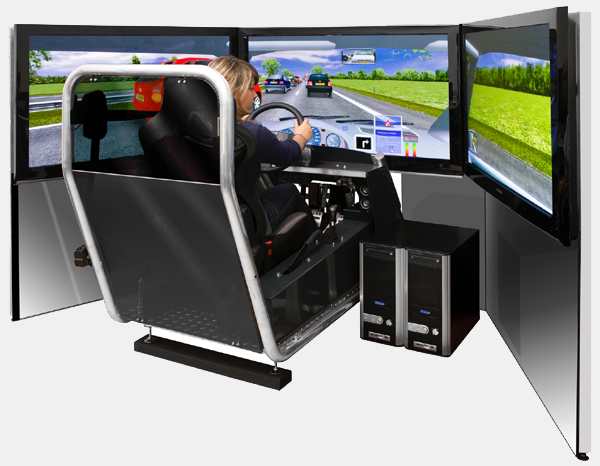Driving simulators for driver training and research
ST Software provides low-cost driving simulators for driver training and behavioural research.
Advantages of our simulators for driver training
![]()
- A guaranteed level of quality for all students
- Training in a safe environment without stress and a guaranteed supply of traffic situations: this increases the effectiveness of training substantially
- Fewer hours on the road: reduces fuel consumption which is good for the environment: one hour in the simulator gives a CO2 emission which is 13x less than one hour in a car
- One instructor can control up to four simulators simultaneously which increases turnover
- High quality of training in less time and at lower cost
- Students get their driving licence faster
- Driver training can be offered for a lower price which gives a competitive advantage
- The driving simulator is very suitable for trainees with fear of driving
Scientific publications
![]()
 |
Kappe, B., Van Winsum, W. & Korteling, H. (in press). A Virtual Driving Instructor: Specification and implementation. DSC-NA 2003, Ohio, US. |
 |
Kapp, B., Van Winsum, W. & Van Wolffelaar, P. (2002). A cost-effective driving simulator. DSC2002 Driving Simulation Conference, Paris, France. Inrets-Renault, 123-133. |
 |
Van Winsum, W. & Korteling, J.E. (1998). Low-cost simulators 3b: Task analysis for driving simulation (Report TM-98-A041). Soesterberg, The Netherlands: TNO Human Factors Research Institute. |
 | Van Wolffelaar, P.C. & Van Winsum, W. (1995). Traffic modelling and driving simulation-an integrated approach. In: DSC95. Driving simulation conference. Conference proceedings. Toulouse: Teknea, 236-244. |
 | Wierda, M., Van Wolffelaar, P. & Van Winsum, W. (1994). Virtual environments: Fundamental and applied aspects. In: F.J. Maarse, A.E. Akkerman, A.N. Brand, L.J.M. Mulder and M.J. van der Stelt (Eds.). Computers in Psychology 5. Applications, methods and instrumentation. Swets & Zeitlinger B.V., Lisse, 206-217. |
 | Van Wolffelaar, P.C. & Van Winsum, W. (1994). A driving simulator for traffic research using a graphical workstation. In: F.J. Maarse, A.E. Akkerman, A.N. Brand, L.J.M. Mulder and M.J. van der Stelt (Eds.). Computers in Psychology 5. Applications, methods and instrumentation. Swets & Zeitlinger B.V., Lisse, 218-229. |
 | Wierda, M., Van Wolffelaar, P.C. & Van Winsum, W. (1993). Immersive Virtual Environments as trainer: system design from a cognitive stance. In: Virtual Interfaces: Research and Applications. AGARD Conference Proceedings 541. North Atlantic Treaty Organization, 1-6. |
 | Van Winsum, W. & Van Wolffelaar, P.C. (1993). GIDS Small World simulation. In: Michon (ed.), Generic Intelligent Driver Support. Taylor & Francis, London, 175-191. |
 | McLoughlin, H.B., Michon, J.A., Van Winsum, W. & Webster, E. (1993). GIDS intelligence. In: Michon (ed.), Generic Intelligent Driver Support. Taylor & Francis, London, 89-112. |
 | Van Wolffelaar, P. & Van Winsum, W. (1992). VSC-Rijsimulator: nieuw en veelzijdig onderzoeksinstrument. Verkeerskunde, 11, 26-29. |
 | Wolffelaar, P.C. Van & Winsum, W. Van. (1992). A new driving simulator including an interactive intelligent traffic environment. In: Proceedings of the 3rd international conference on vehicle navigation & information systems: 499-506. IEEE Service Center, Piscataway NJ. |
 | Van Winsum, W. (1999). The human element in car following models. Transportation Research Part F: Traffic Psychology and Behaviour, 207-211. |
 | Van Winsum, W. (2000). Measuring drowsiness and impairment in car driving. In: Proceedings Vision in Vehicles 8, Boston, augustus 1999. |
 | Van Winsum, W. (1999). Het functionele visuele veld als een indicator voor de werklast. In: Proceedings congres Ergonomie in uitvoering, november 1999, 182-189 |
 | Van Winsum, W; Brookhuis, K.A.; De Waard, D. (2000). A comparison of different ways to approximate Time-to-Line Crossing (TLC) during car driving. Accident Analysis and Prevention, 32, 47-56 |
 | Van Winsum, W; Brookhuis, K.A.; De Waard, D. (1999). Lane change manoeuvres and safety margins. Transportation Research Part F: Traffic Psychology and Behaviour, 139-149. |
 | Van Winsum, W. (1998). Preferred time headway in car-following and individual differences in perceptual-motor skills. Perceptual and Motor Skills, 87, 863-873. |
 | Van Winsum, W. (1998). Indicators of drowsiness and impairment in car driving (Memo 1998-M45). Soesterberg, The Netherlands: TNO Human Factors Research Institute. |
 | Van Winsum, W., Brookhuis, K.A. & De Waard, D. (1998). Kenmerken van rijstrookwisselingen (Report TM-98-D004). Soesterberg, The Netherlands: TNO Human Factors Research Institute. |
 | Van Winsum, W., Brookhuis, K.A. & De Waard, D. (1998). Approximations of Time-to-Line Crossing (TLC) for real time measurement during car driving (Report TM-98-B008). Soesterberg, The Netherlands: TNO Human Factors Research Institute. |
 | Van Winsum, W. (1997). A model of driver behaviour adaptation. In: Brookhuis, K., De Waard, D. & Weikert, C. Simulators and Traffic Psychology. Proceedings of the HFES Europe Chapter Annual Meeting in Haren, The Netherlands, November 1996. Groningen, The Netherlands: The Centre for Environmental and Traffic Psychology, University of Groningen. |
 | Van Winsum, W. & Brouwer, W. (1997). Time headway in car following and operational performance during unexpected braking. Perceptual and Motor Skills, 84, 1247-1257. |
 | Van Winsum, W. & Heino, A. (1996). Choice of time-headway in car-following and the role of time-to-collision information in braking. Ergonomics, 39(4), 579-592. |
 | Van Winsum, W. & Godthelp, H. (1996). Speed choice and steering behavior in curve driving. Human Factors, 38(3), 434-441. |
 | Van Winsum, W. (1996). From adaptive control to adaptive driver behaviour. PhD Thesis. Haren., The Netherlands: Traffic Research Centre, University of Groningen. |
